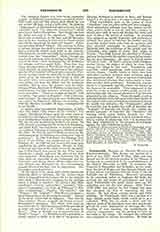

Portsmouth, Diocese of (PORTUS MAGNETS, or PORTEMUTHENSIS). This diocese was created by a Brief of Leo XIII, dated May 19, 1882, and was formed out of the western portion of the Diocese of Southwark as constituted at the reestablishment of the English Hierarchy in 1850. It comprises the Counties of Hampshire and Berkshire, on the mainland, the Isle of Wight, and the Channel Islands, and is thus almost coterminous with the limits of the old Catholic See of Winchester. However, according to its consistent policy in England, the Holy See avoided the old center of government and fixed upon Portsmouth—the great naval port—as the cathedral city for the new diocese. John Virtue (1826-1900) was named its first bishop, and upon him devolved the task of organizing the new diocese. He had about seventy priests and forty missions. In Portsmouth there was a portion of a large church, newly built, which would serve as a cathedral. With this he made a start, and the eighteen years of his episcopate was a slow and steady growth in every department of diocesan life—the founding of new missions, the establishment of religious communities, and the gradual increase in the ranks of the clergy. He enlarged the cathedral and completed its interior decorations. He built an episcopal residence and a large hall adjoining, which, with the cathedral, form a group of buildings artistic in design, and architecturally, the most noteworthy structure, among the ecclesiastical buildings in the Borough of Portsmouth. The Diocesan College at Woolhampton was extended as regards accommodation, and the buildings reconstructed through the generosity of a benefactress. The bishop’s influence in Ports-mouth was great. He was well known in all branches of public life, and at his death the esteem in which he was held by the people of the borough, was attested by their liberal subscriptions to his memorial chapel in the cathedral. He was succeeded by his auxiliary bishop and vicar-general, John Baptist Cahill (1841-1910), a man of exceptional administrative ability.
Bishop Cahill had been Rector of Ryde since 1868, and vicar-general of the diocese since its foundation, he was consecrated coadjutor (titular of Thagora) only three weeks before the death of Bishop Virtue. The ten years of his episcopate were marked by the same steady progress that characterized his predecessor’s. He completed the cathedral by adding the west front, and carried out several important changes in the interior. His episcopate was particularly marked by the influx of religious communities, owing to the French persecutions. It was thus that the diocese was enriched by the presence of such congregations as the Benedictines of Solesmes, both monks and nuns. Five Abbeys (Douai, Quarr, Farnborough, Ryde, and East Cowes) have been founded in the diocese. The good which they and the other exiled religious are doing should alone suffice to perpetuate the memory of Bishop Cahill. He died August 2, 1910, and was succeeded by his friend and auxiliary, William Timothy Cotter (1866) who was educated at Maynooth for the Diocese of Cloyne (Ireland), but afterwards came to the English Mission. He was consecrated auxiliary to Bishop Cahill, March 19, 1905, as titular Bishop of Clazomena, and was transferred to Portsmouth, November 24, 1910. The statistics of 1910 were: churches, 100; secular clergy, 70; regulars, 203; communities of men, 21; of women, 43. The estimated Catholic population, 45,000.
JOHN HENRY KING

